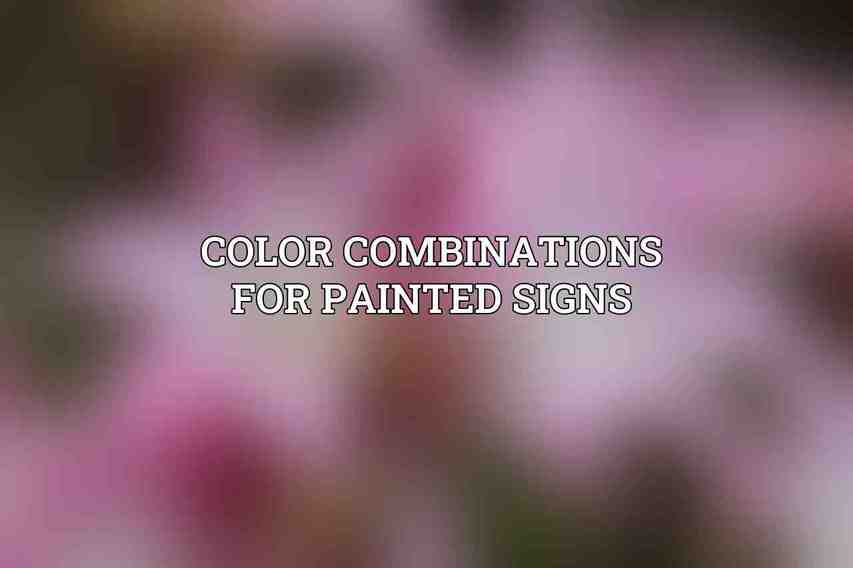color plays a crucial role in capturing attention, conveying messages, and creating memorable experiences for viewers. The choice of colors can significantly impact how a sign is perceived and the emotions it evokes in the audience. Understanding the psychology of colors and their effects is essential for creating effective signage that resonates with people on a subconscious level.
| Product | Description | Price | Link | ||||||||||||||||||||||||||||||||||||||||||||||||||||||||||||||||||||||||||||||||||||||||||||||||
|---|---|---|---|---|---|---|---|---|---|---|---|---|---|---|---|---|---|---|---|---|---|---|---|---|---|---|---|---|---|---|---|---|---|---|---|---|---|---|---|---|---|---|---|---|---|---|---|---|---|---|---|---|---|---|---|---|---|---|---|---|---|---|---|---|---|---|---|---|---|---|---|---|---|---|---|---|---|---|---|---|---|---|---|---|---|---|---|---|---|---|---|---|---|---|---|---|---|---|---|
| Corrugated Plastic Sign | Weather-resistant, ideal for outdoor use | Starting at $12.95 | View Product | ||||||||||||||||||||||||||||||||||||||||||||||||||||||||||||||||||||||||||||||||||||||||||||||||
| Foam Board Sign | Lightweight, versatile, can be used indoors or outdoors | Starting at $24.95 | View Product | ||||||||||||||||||||||||||||||||||||||||||||||||||||||||||||||||||||||||||||||||||||||||||||||||
| Magnetic Sign | Easily removable, perfect for vehicles or metal surfaces | Starting at $19.95 | View Product | ||||||||||||||||||||||||||||||||||||||||||||||||||||||||||||||||||||||||||||||||||||||||||||||||
| Banners | Durable, large-format printing for events or promotions | Starting at $89.95 | View Product | ||||||||||||||||||||||||||||||||||||||||||||||||||||||||||||||||||||||||||||||||||||||||||||||||
| Visit Signs, Banners, and Magnets On The Cheap | |||||||||||||||||||||||||||||||||||||||||||||||||||||||||||||||||||||||||||||||||||||||||||||||||||
Importance of color in signage
Colors have the power to influence emotions, behaviors, and perceptions. They can evoke specific feelings, communicate messages, and even guide decision-making processes. By strategically selecting colors for painted signs, businesses can attract customers, enhance brand recognition, and create a strong visual identity in the competitive market.
Psychological effects of colors
Different colors are known to evoke various psychological responses in individuals. For example, red is often associated with passion, energy, and urgency, while blue conveys trust, professionalism, and reliability. Understanding the psychological effects of colors can help businesses choose the right hues to achieve their desired communication goals and connect with their target audience effectively.
Understanding Color Theory

Color theory provides a framework for understanding how colors interact with each other and how they can be combined harmoniously to create visually appealing designs. By grasping the fundamentals of color theory, businesses can make informed decisions when choosing colors for their painted signs.
Color wheel and primary, secondary, and tertiary colors
The color wheel is a visual representation of the relationships between colors. It consists of primary colors (red, yellow, blue), secondary colors (orange, green, purple), and tertiary colors (mixtures of primary and secondary colors). Understanding how colors are positioned on the color wheel can help businesses create cohesive color schemes for their signs.
Color harmonies: complementary, analogous, triadic
Color harmonies refer to combinations of colors that are visually pleasing together. Complementary colors are opposite each other on the color wheel and create high contrast, while analogous colors are adjacent and create a harmonious feel. Triadic colors are evenly spaced around the color wheel and offer a balanced yet dynamic palette for signage.
Color contrast: light vs. dark, warm vs. cool
Contrast is essential for ensuring visibility and legibility in signage. By utilizing contrasting colors, such as light versus dark or warm versus cool hues, businesses can make their signs stand out and grab the attention of passersby. Understanding the principles of color contrast is key to creating impactful painted signs.
Choosing Colors for Your Sign
When selecting colors for painted signs, several factors should be taken into consideration to ensure that the chosen hues effectively communicate the intended message and resonate with the target audience.
Consider your target audience
The preferences, demographics, and psychographics of the target audience should influence color choices. For example, a children’s play area may benefit from vibrant and playful colors, while a law firm may opt for more subdued and professional hues. Understanding who will be viewing the sign can guide color decisions.
Determine the purpose of the sign
The function and goals of the sign should also inform color choices. A sale sign may use bold and attention-grabbing colors to drive immediate action, while a directional sign may prioritize clarity and contrast for easy readability. Aligning color choices with the sign’s purpose enhances its effectiveness.
Test different color combinations to find the best fit
Experimenting with various color combinations through mock-ups or digital designs can help businesses visualize how different hues work together in the context of their signage. Testing colors under different lighting conditions and backgrounds can reveal which combinations are most impactful and visually appealing.
Specific Color Recommendations
While individual preferences and branding considerations play a significant role in color selection, certain colors are commonly associated with specific traits and emotions that can guide businesses in their decision-making process.
| Color | Characteristics | Associations |
|---|---|---|
| Red | Bold, attention-grabbing | Energy, passion, urgency |
| Orange | Friendly, playful | Vibrancy, creativity |
| Yellow | Optimistic, bright | Cheerfulness, optimism |
| Green | Peaceful, natural | Harmony, growth, freshness |
| Blue | Trustworthy, calming | Professionalism, reliability |
| Purple | Luxurious, creative | Sophistication, royalty |
Red:
Red is a color that commands attention and is often used to convey urgency or energy. It can be an excellent choice for businesses looking to make a bold statement with their signage.
Orange:
Orange is a friendly and playful color that can evoke feelings of vibrancy and creativity. It is often used to add a fun and inviting touch to signage.
Yellow:
Yellow is a bright and optimistic color associated with cheerfulness and optimism. It can be an effective choice for businesses looking to create a welcoming and uplifting atmosphere with their signs.
Green:
Green is a soothing and natural color that symbolizes harmony, growth, and freshness. It is frequently used by businesses to convey eco-friendliness or a sense of tranquility.
Blue:
Blue is a trustworthy and calming color that is often associated with professionalism and reliability. It is a popular choice for businesses seeking to establish credibility and instill confidence in their audiences.
Purple:
Purple is a luxurious and creative color that conveys sophistication and royalty. It can be an excellent option for businesses aiming to portray elegance and creativity in their signage.
Color Combinations for Painted Signs

Combining colors thoughtfully can enhance the visual impact of painted signs and create memorable impressions on viewers. Certain color combinations are known for their versatility, aesthetics, and ability to convey specific moods.
Black and white:
The classic combination of black and white exudes elegance, timelessness, and versatility. It is a popular choice for signage that aims to achieve a sleek and sophisticated look.
Navy and gold:
Navy and gold create a sophisticated and regal pairing that is often associated with luxury and nautical themes. This combination can add a touch of elegance and prestige to painted signs.
Teal and yellow:
Teal and yellow form a vibrant and creative duo that captures attention and infuses a tropical or energetic vibe into signage designs. This combination is suitable for businesses looking to stand out and evoke a sense of playfulness.
Green and white:
Green and white harmonize to create a natural, organic, and refreshing palette that is ideal for conveying eco-friendliness, freshness, and serenity. This combination is well-suited for businesses with an emphasis on sustainability and nature.
Red and white:
Red and white offer a high-contrast pairing that is bold, impactful, and attention-grabbing. This classic combination is often used to create signage that demands immediate attention and conveys a sense of urgency.
Tips for Choosing Colors
To ensure that the colors chosen for painted signs effectively communicate messages and resonate with viewers, businesses can follow several practical tips for color selection and implementation.
Use contrast for legibility
High contrast between background and text colors enhances legibility and visibility, especially from a distance or in varying lighting conditions. Utilizing complementary colors or light versus dark contrasts can improve readability on signs.
Consider the lighting conditions
The lighting environment where the sign will be displayed should be taken into account when choosing colors. Natural and artificial lighting can affect how colors appear, so testing colors under different lighting conditions can help ensure that the sign remains visually appealing and impactful.
Test colors on-site before committing
Before finalizing color choices for painted signs, it is advisable to create a physical mock-up or use digital tools to visualize how the colors will look in the actual setting. Testing colors on-site allows businesses to make adjustments and ensure that the chosen hues achieve the desired visual impact.
Use a color consultant if needed
For businesses that may find color selection challenging or overwhelming, consulting with a color expert or designer can provide valuable insights and guidance. Color consultants can offer professional advice on color combinations, trends, and visual communication strategies to help businesses create effective signage.
Resources for Choosing Colors
When in need of inspiration, guidance, or tools for choosing colors for painted signs, businesses can explore various online resources and platforms dedicated to color theory and design aesthetics.
Signs, Banners, and Magnets On The Cheap SignsOnTheCheap
Signs, Banners, and Magnets On The Cheap offers a wide range of color options for custom signage, providing businesses with diverse choices to suit their branding needs. Additionally, the platform provides color consultation services and features a gallery of custom painted signs to inspire ideas for unique designs.
Color Wheel Pro ColorWheelPro
Color Wheel Pro is a comprehensive online tool that helps businesses explore color combinations, generate color harmonies, and understand the principles of color contrast. The platform offers valuable resources for businesses seeking to enhance their understanding of color theory and create visually appealing signage.
ColorSnap Visualizer SherwinWilliams
Sherwin-Williams’ ColorSnap Visualizer is a virtual painting tool that allows businesses to experiment with different color combinations on photos of their signs. By simulating how colors will look in real-life settings, businesses can make informed decisions about paint colors and create visually impactful signage.
By leveraging these resources and recommendations, businesses can navigate the complexities of color selection for painted signs with confidence and creativity, ensuring that their signage stands out, communicates effectively, and leaves a lasting impression on viewers.
Frequently Asked Questions
What are some popular colors for painted signs?
Popular colors for painted signs include red, blue, green, yellow, and black. These colors are versatile and make your signs easily noticeable.
How should I choose colors that stand out?
To choose colors that stand out, consider using high-contrast combinations like black and white, or complementary colors like blue and orange. These combinations catch the eye and make your sign easy to read.
Are there any colors to avoid for painted signs?
Avoid using colors that are too similar in hue or value, as they can blend together and make your sign hard to read. Additionally, fluorescent colors may be difficult to read in certain lighting conditions.
Should I consider the psychology of colors when choosing paints for signs?
Yes, the psychology of colors can play a big role in the effectiveness of your sign. For example, red can convey energy and urgency, while blue can promote trust and reliability. Consider the message you want to convey with your sign when selecting colors.
Can I use different shades of the same color on a painted sign?
Using different shades of the same color can add depth and visual interest to your sign. However, be mindful of contrast and legibility when using monochromatic color schemes.

